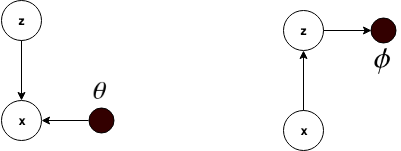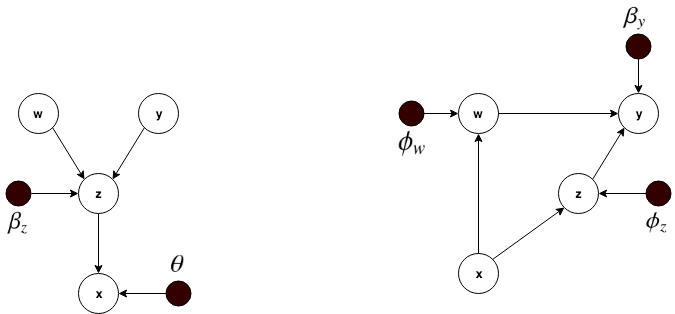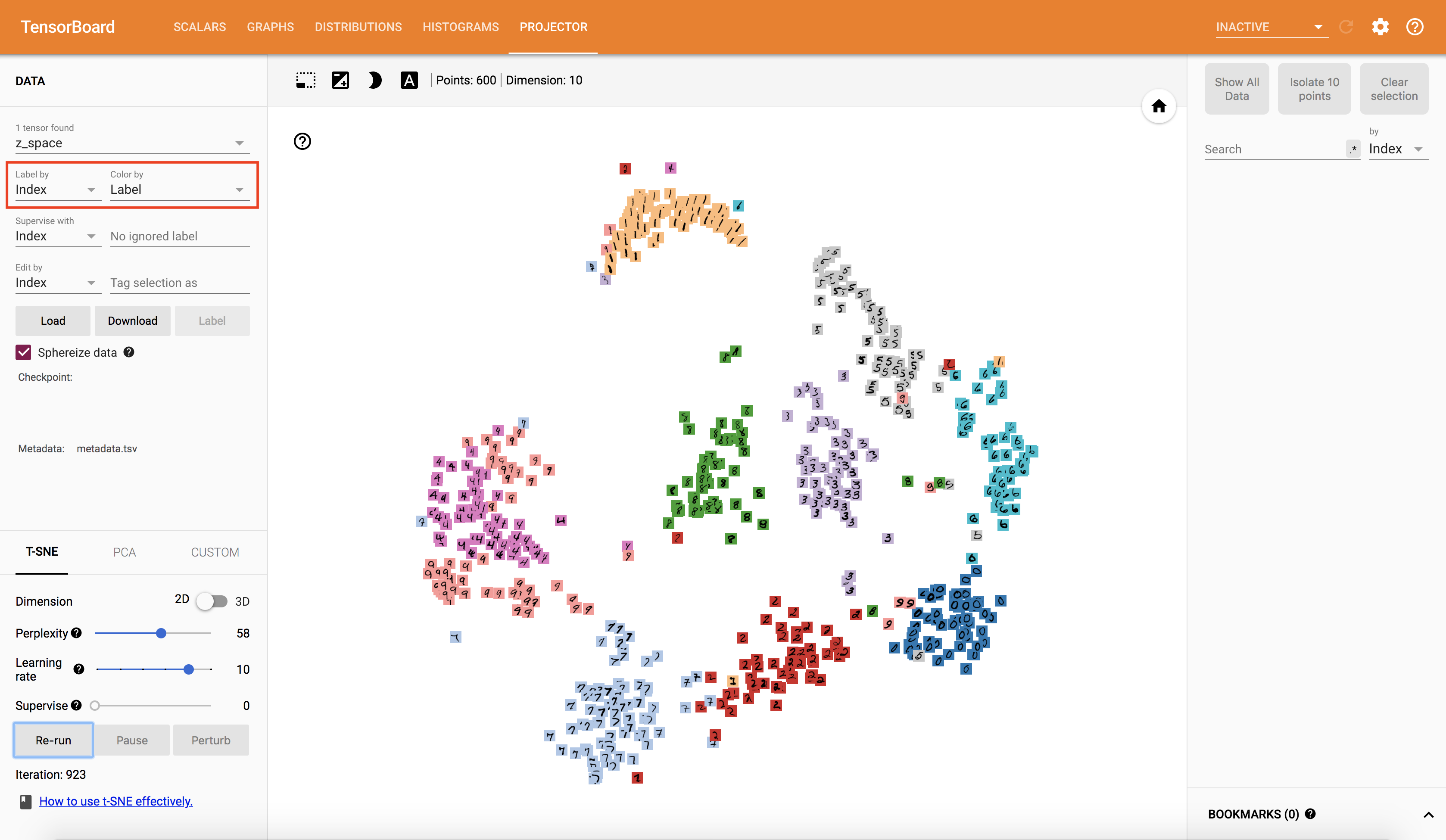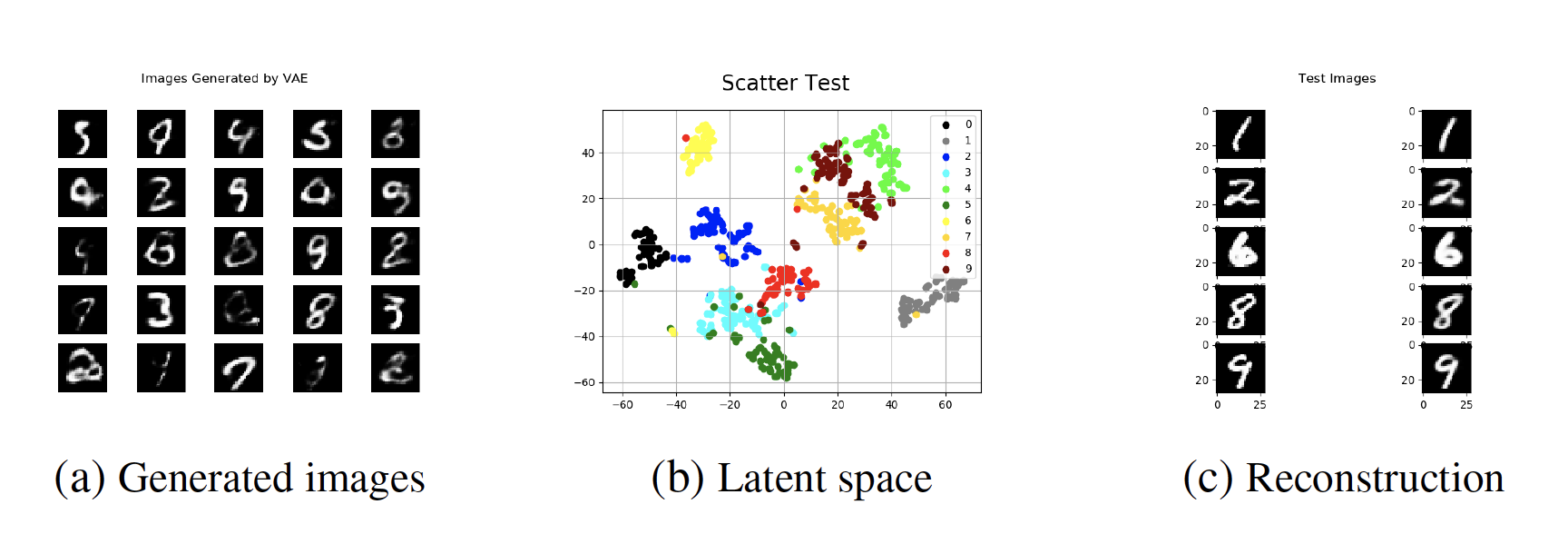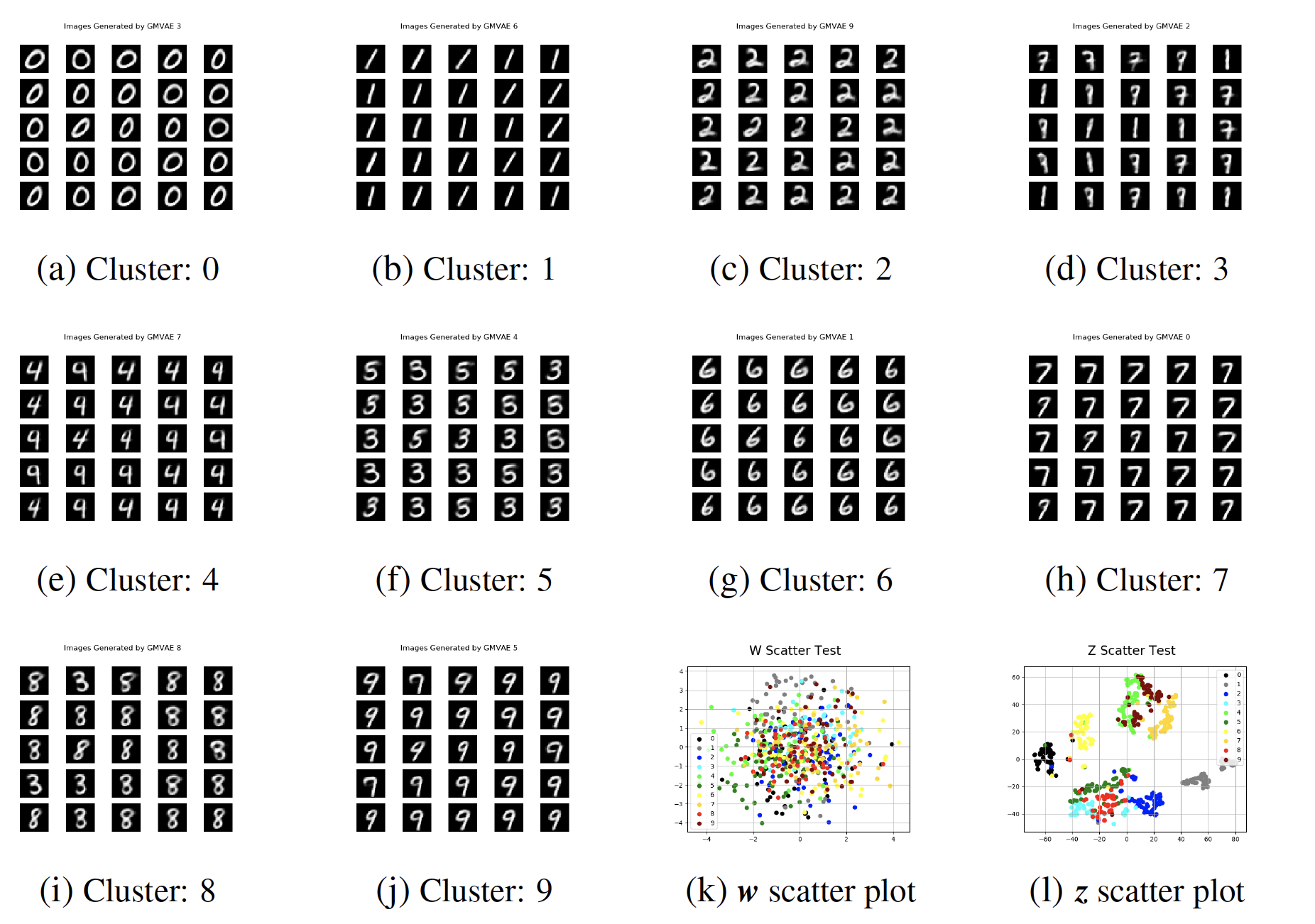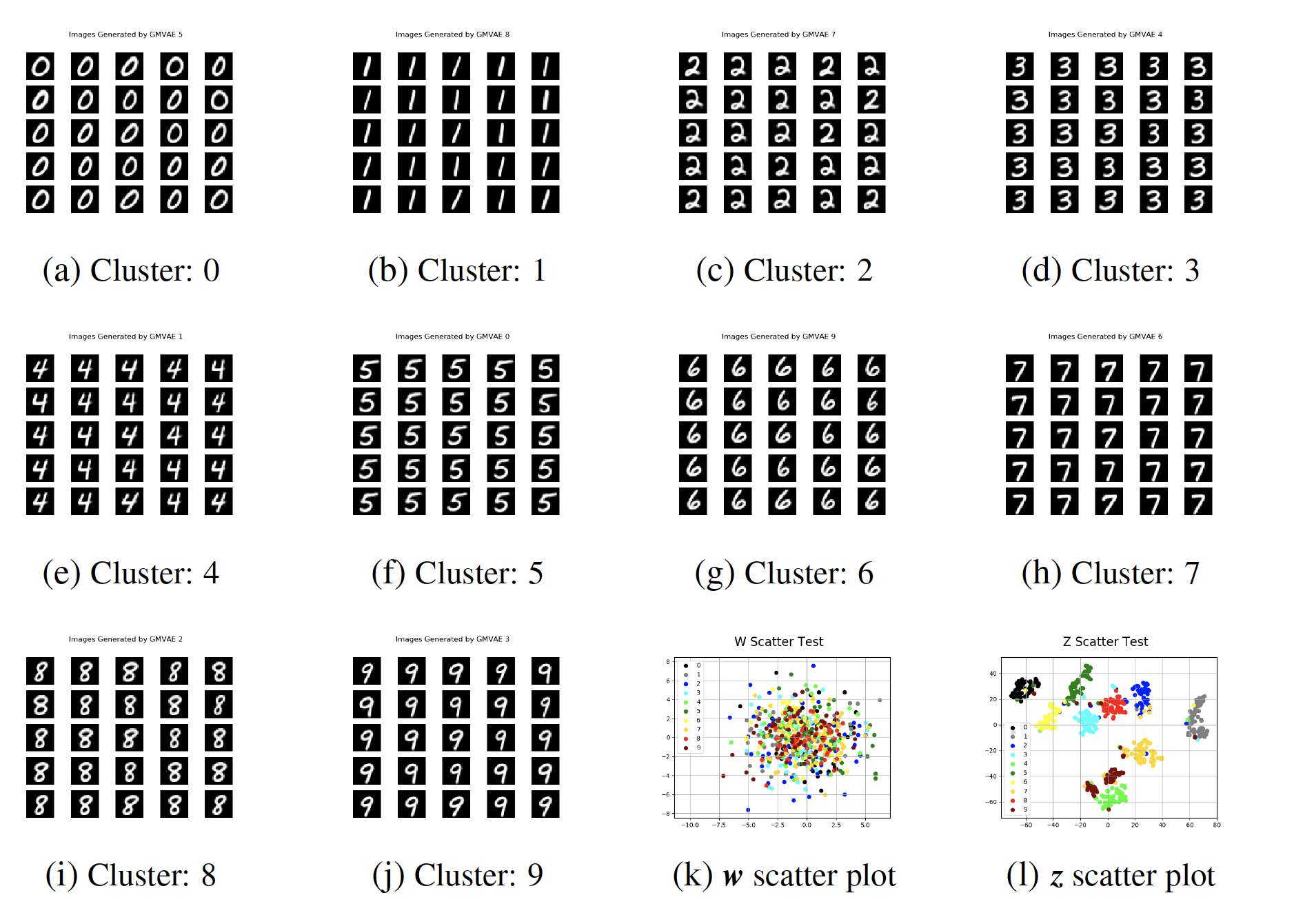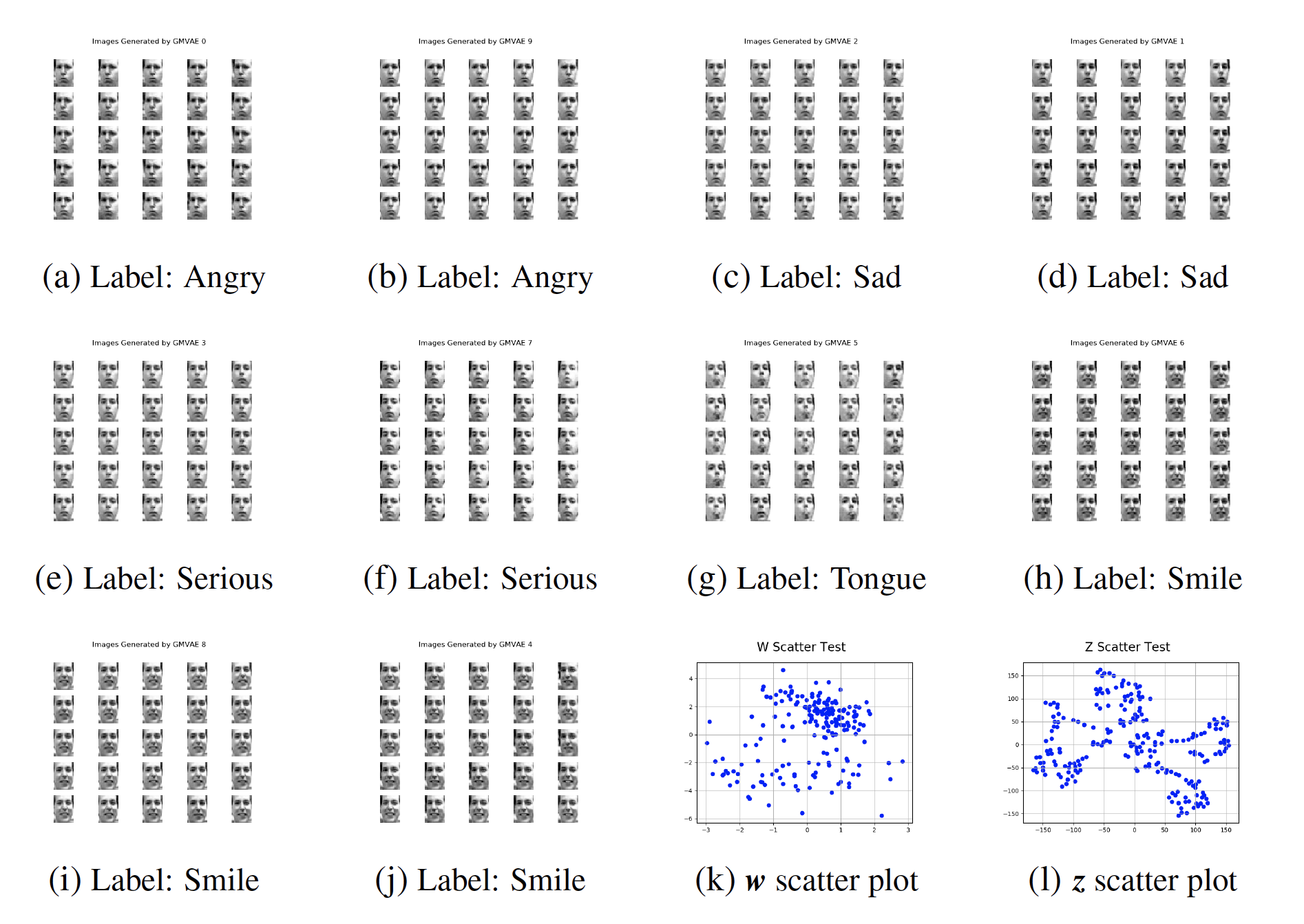This repository contains the implementation of the VAE and Gaussian Mixture VAE using TensorFlow. The VAE implementation is completeley based on the model described in link and the GMVAE implementation is based on the model presented in link with some modifications in the optimization function and the implementation of some distributions. These modifications are described in the Chapter 4 of this bachelor thesis
- Install Tensorflow
- Install Matplotlib
- Install Numpy
The image below shows the graphical model for the VAE.The variable x represents the input data and the variable z represents the latent space. The left part is the generative model and the right part is the inference model.
The image below shows the graphical model for the GMVAE.The variable x represents the input data and the variables w,y,z represent the latent space. The left part is the generative model and the right part is the inference model.For a complete explanation of both models see Chapter 3 and Chapter 4 of the bachelor thesis (soon available).
These are the functions that are optimized during training. It can be observed both contains a term that will be maximized (blue) and one or more terms that are regularizers (red).
For the VAE:
For the GMVAE:
For a complete explanation of both models see Chapter 3 and Chapter 4 of the bachelor thesis (soon available).
The following hyperparameters are defined. Some of them handle the files generated, others deal with saving and restoring a model and others determine certain aspects of the algorithm.
Parameters to handle aspects of the training process and the neural networks:
--model_type MODEL_TYPE Fixes the model and architecture
--dataset_name DATASET_NAME MNIST or FREY
--epochs EPOCHS Number of epochs for training
--batch_size BATCH_SIZE Number of inputs used for each iteration
--sigma SIGMA Parameter that defines the variance of the output Gaussian distribution
--learning_rate LEARNING_RATE Parameter of the optimization function
--z_dim Z_DIM Dimension of the latent variable z
--w_dim W_DIM Dimension of the latent variable w. Only for GMVAE
--K_clusters K_CLUSTERS Number of modes of the latent variable z. Only for GMVAE
--hidden_dim HIDDEN_DIM Number of neurons of each dense layer
--num_layers NUM_LAYERS Number of dense layers in each network
Parameters to set checkpoint, results, log and data directories:
--checkpoint_dir CHECKPOINT_DIR Directory name to save the checkpoints
--result_dir RESULT_DIR Directory name to save the generated images
--log_dir LOG_DIR Directory name to save training logs
--data_dir DATA_DIR Directory for storing input data
Parameters used to enable/disable training, tensorboard summay, model load, plot and generation of results:
--train TRAIN Flag to set train
--summary SUMMARY Flag to set TensorBoard summary
--restore RESTORE Flag to restore model
--plot PLOT Flag to set plot
--results RESULTS Flag to get results
--early_stopping EARLY_STOPPING Flag to enable early stopping
Other parameters:
--extra EXTRA Extra name to identify the model
This project contains the following folders:
- Alg_*: contains the files needed to implement a certain algorithm. These files are described in the following section
- base: base classes for Graph, Model and Visualize
- networks: classes encapsulating the implementation of CNN, dense and RNN networks.
- utils: diverse files to manage arguments, data and training things (early stopping, logger...)
In the models implemented we can differentiate 3 main parts: computation graph (ex. VAE_graph.py), training (ex. VAE_model.py) and visualization (ex. VAE_visualize.py).
- XX_graph.py: contains the class that defines the computation graph of the algorithm and methods to obtain specific parameters
- XX_model.py: contains the class that generates the computation graph, defines the training process and the evaluation of the trained model.
- XX_visualize.py: contains the class that contains methods to visualize the results.
- XX_main.py: This is the main file. It manages the arguments, it loads the data and it instantiates the previous objects.
The selection of an architecture is done through the model_type parameter. It can take the following values:
- 0: VAE implemented using dense neural networks. [VAE_graph.py]
- 1: VAE implemented using CNNs. [VAECNN_graph.py]
- 2: GMVAE implemented using dense neural networks [GMVAE_graph.py]
- 3: GMVAE implemented using CNNs. [GMVAECNN_graph.py]
Models are saved following the following naming. For the VAE it has 6 fields (+ extra):
{model_type}_{dataset_name}_{sigma}_{dim_Z}_{hidden_dim}_{num_layers}
For the GMVAE it has the previous field plus "dim_Z" and "K_clusters", which makes 8 in total (+ extra):
{model_type}_{dataset_name}_{sigma}_{dim_Z}_{dim_W}_{hidden_dim}_{num_layers}_{K_clusters}
Example: V_MNIST_0001_8_64_2
It is possible to visualize the evolution of parameters during training and the latent variables in TensorBoard. It can be done executing the tensorboard command indicating the log folder of the trained model:
tensorboard--logdir=LOGDIR/MODEL_SAVED/
For example, if the following model's configuration is trained:
python3 VAE_main.py --model_type=0 --dataset_name=MNIST --sigma=0.001 --z_dim=8 --hidden_dim=64 --num_layers=2 --epochs=20 --batch_size=32 --drop_prob=0.3 --l_rate=0.01 --train=1 --results=1 --plot=1 --restore=1 --early_stopping=1
then it is possible to open TensorBoard and see the parameters of the previous model:
tensorboard --logdir=./expeiments/summary/V_MNIST_0001_8_64_2/
Tensorflow will be opened in a browser and you will see 5 tabs: SCALARS, GRAPHS, DISTRIBUTIONS, HISTOGRAMS AND PROJECTOR. The two screenshots below show the PROJECTOR tab, which shows several inputs images projected in the latent space through t-SNE.
Training and results of VAE using MNIST dataset:
python3 VAE_main.py --model_type=0 --dataset_name=MNIST --sigma=0.001 --z_dim=8 --hidden_dim=64 --num_layers=2 --epochs=20 --batch_size=32 --drop_prob=0.3 --l_rate=0.01 --train=1 --results=1 --plot=1 --restore=1 --early_stopping=1
Load previously trained GMVAECNN using FREY dataset, generate results and plot them:
python3 GMVAE_main.py --model_type=3 --dataset_name=FREY --sigma=0.001 --z_dim=8 --w_dim=2 --K_clusters=8 --hidden_dim=64 --num_layers=2 --epochs=20 --batch_size=32 --drop_prob=0.3 --l_rate=0.01 --train=0 --results=1 --plot=1 --restore=1 --early_stopping=1
In the title of the generated images "Images generated by GMVAE X" the "X" refers to the cluster index, not to the actual class.
Good generative result:
Good clustering result:
Using MNIST dataset:
Using FREY dataset, the labels have been manually:
- C. Doersch, “Tutorial on Variational Autoencoders,” ArXiv e-prints, Jun. 2016. arXiv: https://arxiv.org/pdf/1606.05908.pdf
- N. Dilokthanakul et al., “Deep Unsupervised Clustering with Gaussian Mixture Variational Autoencoders,” ArXiv e-prints, Nov. 2016. arXiv: https://arxiv.org/pdf/1611.02648.pdf
License for all files: Apache License 2.0
If you have any question, please don't hesitate to contact me at pablosan@ing.uc3m.es
